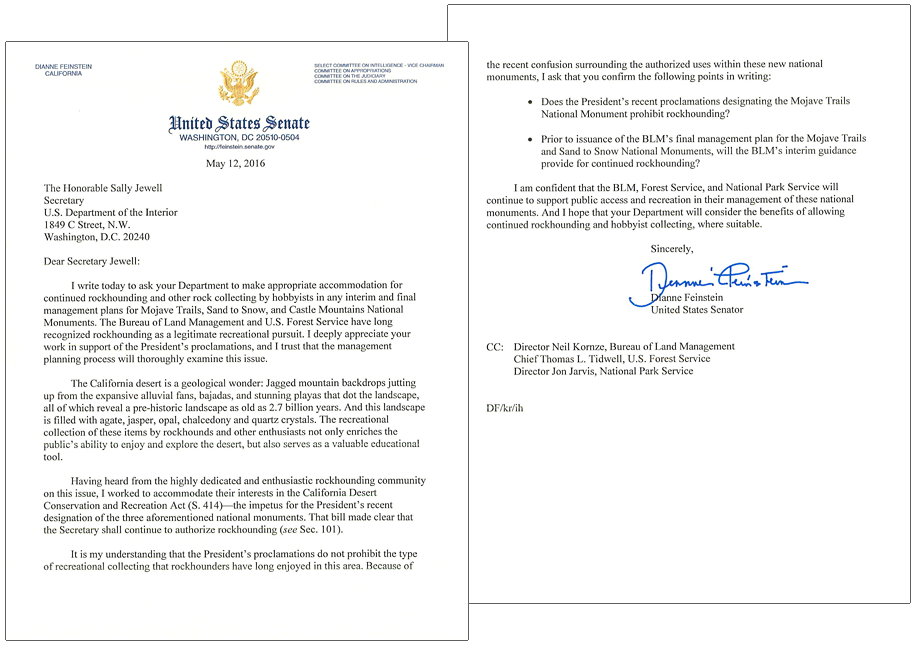Public Lands update.
October 4, 2016
by Lisbet Thoresen
#CalNatMonuments Tweet
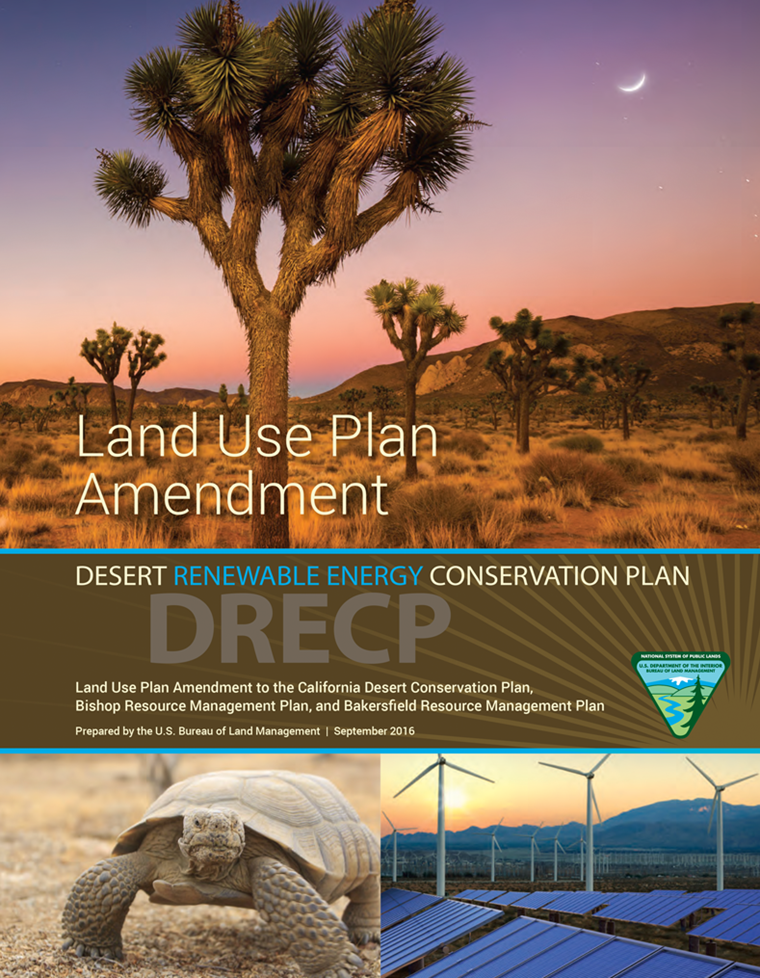
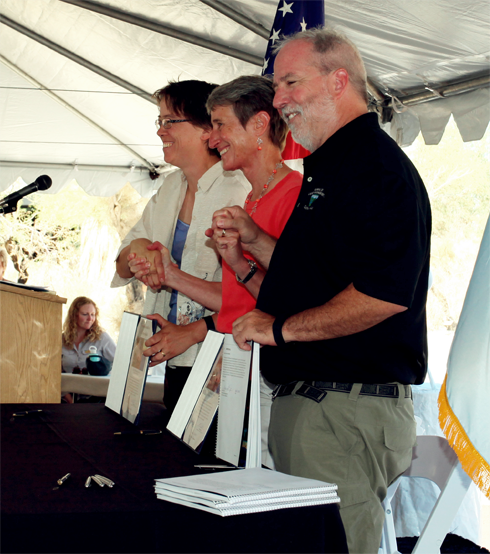
The DRECP Phase 1 Record of Decision was signed by Karen Douglas, Commissioner of the California Energy Commission; Jerome Perez, Director of California BLM; and Sally Jewell, Secretary of the Interior.
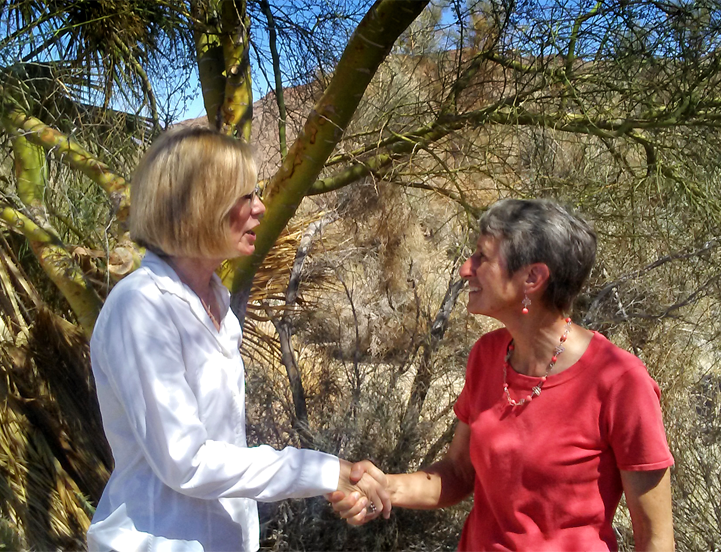
Lisbet Thoresen speaks with Secretary Sally Jewell about rock collecting in National Monuments at the DRECP signing ceremony held in Palm Desert on Sept 14,2016. Photo: L. Barrett.
What's in the Phase I LUPA?
Phase I identifies Development Focus Areas (DFAs), Variance Process Lands (VPLs), and Unallocated Lands to be made available for renewable energy projects while setting aside areas with conservation and recreational values. The principal components of the Final BLM LUPA are:
- Development Focus Areas (DFAs). Approximately 800,000 acres of land may be made available for renewable energy development, with 388,000 acres designated as Development Focus Areas (DFA).
- Variance Process Lands (VPLs). Approximately 40,000 acres where renewable energy development may be considered and could be approved without a plan amendment.
- General Public Lands ("Unallocated Lands" in the Proposed LUPA and Final EIS). 419,000 acres of General Public Lands and 35,000 acres of Extensive Recreation Management Areas (ERMAs) (not overlaid by a conservation allocation) where renewable energy development may also be considered, but a plan amendment would be necessary as part of project review and approval.
- BLM Conservation Areas. Area of Critical Environmental Concern (ACEC) and Wildlife Allocation are approved designations. California Desert National Conservation Lands (CDNCL) is a designation identified under the Omnibus Act.
- Recreation Management Areas. Special Recreation Management Area (SRMA) and ERMA (see General Public Lands above) are approved designations. Approximately 2,691,000 acres are designated SRMAs and 903,000 acres are designated ERMAs. As noted above, ERMAs that do not have a conservation allocation overlay are available for renewable energy development, subject to a site-specific plan amendment.
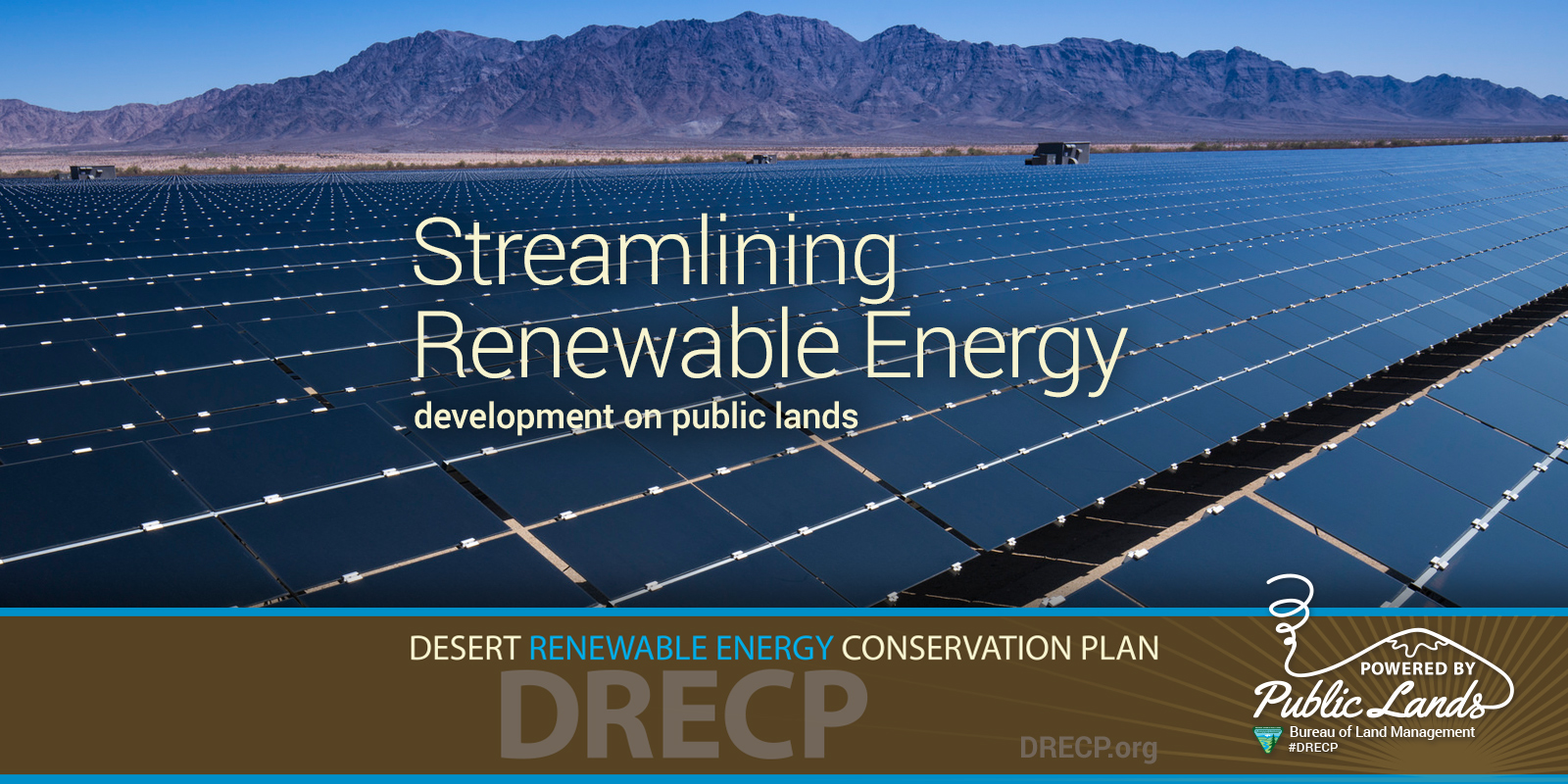
Attend the California Desert
District Advisory Council (DAC)
meeting in Riverside
Sat, October 15, 2016 8:00am – 5:00pm
Location: University of California Riverside
Extension Center
Conference Rooms D-E
1200 University Avenue
Riverside, CA 92507
Be sure to double check
the meeting location & agenda
on the BLM website
shortly before the meeting date.
https://goo.gl/5vr3hW (short url)
Agenda for the Saturday meeting will include updates by council members, the BLM California Desert District Manager, five Field Managers, and council subgroups. Beth Ransel, the newly appointed California Desert District (CDD) manager, will be introduced, along with Douglas Herrema, the new manager for the Palm Springs-South Coast Field Office. The Council will discuss the DRECP. BLM Field Officer (Needles) Mike Ahrens will make a presentation on the Management Plan process for the Mojave Trails National Monument.
Submit written comments
prior to the meeting
- Bureau of Land Management
External Affairs
22835 Calle San Juan de Los Lagos
Moreno Valley, CA 92553 - Written comments also are accepted at the time of the meeting and, if copies are provided to the recorder, will be incorporated into the minutes.
The 15-member council advises the Secretary of the Interior, through the BLM, on a variety of planning and management issues associated with public land management on BLM administered lands in the California desert. Public comment for items not on the agenda will be scheduled at the beginning of the meeting on Saturday morning.
Time for public comment is made available by the council chair during the presentation of various agenda items, and is scheduled at the end of the meeting for topics not on the agenda.
Members of the public interested in a particular agenda item or discussion should schedule their arrival accordingly.
For more information contact:
Stephen Razo
BLM California Desert District External Affairs
951-697-5217 or srazo@blm.gov
DAC Meeting in Riverside
or https://federalregister.gov
(Search: DAC Riverside 2016)
Three major Public Lands Policy milestones have significant near- and long-term implications for Rockhounding in Southern California: the Desert Renewable Energy Conservation Plan (DRECP) and two National Monuments (NM) – Mojave Trails NM and San Gabriel Mountains NM. A presentation made by the author at the SDMG General Meeting in September discusses these watershed milestones in the context of land use policy developments and what they portend for the next 25 years. The presentation also addresses what Rockhounds need to understand about the NM Management Plan drafting process and how to participate in it, so that it works for them. (Download a print-friendly PDF of the slide deck.)
DRECP update
The Phase I signing ceremony
On September 14, 2016, the Final Land Use Plan Amendment (LUPA) was approved for Phase I of the DRECP. The Record of Decision was signed by Karen Douglas, Commissioner of the California Energy Commission; Jerome Perez, Director of California BLM; and Sally Jewell, Secretary of the Interior. The signing ceremony was held at the visitor center of the Santa Rosa and San Jacinto Mountains National Monument, with ca. 150 attendees present. Not many Rockhounds showed up and few DAC members did, either. I attended and had the opportunity to meet Secretary Jewell. I used it to mention that the CFMS represents 108 affiliate clubs and its 8,747 recreational rockhound members. I reminded her that Senator Dianne Feinstein had sent her a letter on May 12th advocating the accommodation of rockhounding in the Mojave Trails National Monument, adding that our community hoped she would consider adopting the senator's recommendation in the Management Plan for every National Monument as a matter of policy. I stressed that, as adherents of the AFMS code of Ethics, Rockhounding values are consistent with – not in conflict with – the conservation values enshrined in the NM designation.
Why is the DRECP Phase I ROD important, how did it come about, and what did it net Rockhounds?
Given the scope and long gestation of the DRECP, the signing ceremony was a historic milestone. Developed over eight years beginning in the administration of Governor Arnold Swarzenegger and accelerated under Governor Jerry Brown, the DRECP is the most ambitious land use amendment in California state history. It will serve as a "guideline" for administering 22.5 million acres of public and non-federal lands in California's deserts. Its goal is to meet 50% of the state's projected energy needs from renewable energy sources by 2030. Utility-scale projects will be built through public-private partnerships.
Five alternative plans were considered in the 8,000+-page document – none considered a distributed energy generation (e.g., rooftop solar) component. By the time the comment period closed on February 23, 2015, 11 public hearing had been convened and more than 16,000 comment letters had been received. Because the Draft DRECP received very strong criticism, it was decided to roll it out in phases.
The Phase I DRECP LUPA covers 10.8 million acres of BLM-administered lands, of which 5 million acres previously had been designated conservation areas (e.g., National Monuments, wildlife allocations, etc). According to the executive summary for the ROD the BLM LUPA "identifies priority areas for renewable energy development while setting aside millions of acres for conservation and outdoor recreation." Of special interest to Rockhounds, the Final BLM LUPA was revised from the Draft version, changing DFA designated areas where they overlapped rock collecting areas. According to Vicki Campbell, BLM's DRECP Project Manager, these changes were made in response to the "numerous and detailed comment letters" the DRECP received from Rockhound advocates.
Among the many individuals and groups that submitted comment letters, San Diego Mineral & Gem Society submitted a 48-page letter that included comments from more than 185 respondents to a rockhound survey it sponsored from 12/14 to 2/15. Kudos to Rockhounds who took the time to write letters, take the survey, and attend the public meetings – your effort made a difference! Thanks also to non-Rockhounds who lent our community their support, particulary Desert District Advisory Council (DAC) member Randy Banis and conservation blogger Shaun Gonzales.
What's next? Phase II and Planning 2.0
The completion of Phase I paves the way for the DRECP's raison d'être, implementation of Phase II – industrialization of the desert. Phase II focuses on non-federal lands and close cooperation with counties to enable fast-track permitting for renewable energy projects so that as many utilities and power links can be built as quickly as possible. Areas available for building renewable energy projects that were identified in the Phase I BLM LUPA will be integrated into the larger DRECP Plan, which in turn, will be incorporated into the architecture of a power grid connected with renewable energy utilities built throughout the entire United States.
To facilitate the integration and implementation of land use policy into this new complex Framework, planning and decision-making on Management Plans will be centralized in Washington D.C. This Framework, known as the Planning 2.0 initiative, is currently under development. Management Plans currently being drafted will have to be reconciled with and brought into compliance with Planning 2.0 when it is ready to deploy.
Expect to hear more about Planning 2.0 in the months (and years) ahead. Transferring planning and decision-making from local-level oversight to the federal level has unclear, but potentially worrisome implications for changes in land use policy of public lands, particularly for Rockhounds, because recreation is a low-priority value (after conservation and energy development/economic value, which trumps everything). While the meeting agenda for the next DAC business meeting has not been posted on the BLM website as of October 4th, Planning 2.0 probably will be an agenda topic. The DAC meeting is scheduled for October 15th at University of California, Riverside. The formation of a sub-group to advise the Council was approved at the May DAC meeting in Barstow, and the BLM anticipates that the final selection of sub-group members will be announced at the October meeting. If a Rockhound advocate is not appointed to the sub-group, it will be more important than ever for Rockhounds to attend the DAC meetings and have their comments entered into the record.
Mojave Trails National Monument (MTNM)
Management Plan
As many Rockhounds are aware by now, during the interim period while a Management Plan is being drafted for the MTNM, State BLM Director Jerry Perez authorized rock collecting to continue as previously within the Monument. The BLM officially inaugurated the planning process by hosting three "Envisioning Sessions" in Barstow, Yucca Valley, and Needles, on August 30th, 31st, and September 1st, respectively. The events featured posters showcasing different special interests, with presenters available to discuss them. The sessions also provided opportunity for the public to provide written input about what should go into the Management Plan. Many questionnaires were returned with copius comments.
The Barstow meeting had an overflow crowd, with 30–40 rockhounds attending from as far away as San Diego and Chatsworth. BLM field officer Mike Ahrens was asked how long the drafting process might take – he estimated 18–24 months for completion of the Management Plan. To ensure that collecting areas and vehicular access to them will be incorporated into the final LUPA, Rockhounds will need to submit detailed comment letters citing specific collecting areas and travelways to reach them. Places and trails and roads not specifically included in the Final Plan will be off limits ever after.
Many favorite collecting areas are now within the Monument's boundaries, including Afton Canyon, Cady Mountains, Cadiz (Siam Siding), most of Lavic Siding, Jasper Hill and other localities. Because there are so many collecting areas and roads and trails, Rockhounds should not wait to gather information for their letters, but instead, should start working on them now and have them ready to submit when the official comment period opens. The window of opportunity to submit comment letters will be brief.
The author's slide deck covers this topic and provides specific suggestions on what to include in an effective comment letter.
San Gabriel Mountains National Monument (SGMNM)
Management Plan

For everyone who bemoaned the loss of Rockhound habitat when the San Gabriel Mountains National Monument (SGMNM) was created on October 10, 2014, a small window of opportunity exists to petition for getting some of it back. A joint comment letter is being prepared by SDMG and CFMS, which we hope will result in accommodation of rock collecting being written into the Final Record of Decision. We are optimistic about restoring accommodations for recreational rock collecting, if we can galvanize enough support.
To be effective, letters need to be specific and detailed. They take a lot of time to research and write well, so to make it easier for Rockhounds to lend their support, SDMG and CFMS, would like to invite signatories to our letter, specifically other gem-mineral clubs and individuals who have professional affiliations or academic credentials, for example, geologists, mineralogists, museum curators.
We need your help with identifying and describing the collecting areas and also road access within the Monument. Any collecting area not identified in the Management Plan will be off-limits forevermore. (To find out what we need from you, read the article on this topic in the SDMG October bulletin). The article also provides useful resources gathered for your convenience, in case you decide to write your own letter.
If your club/org wants to sign onto the SDMG-CFMS comment letter, please email Lisbet Thoresen (editor@sdmg.org) no later than October 10, 2016.
Download a copy of the current Draft Comment letter (Word doc).
Download a PDF of the current annotated SGMNM maps.
The author's public lands report slide deck covers this topic and provides specific suggestions on what to include in an effective comment letter. It also includes links to useful resources.
Cite this article: L. Thoresen. 4 October 2016. Public Lands update. San Diego Mineral & Gem Society, Inc. Available online at: http://www.sdmg.org/articles/201610/public-lands-update/.
When you tweet this article, use the hashtag #CalNatMonuments. Tweet

